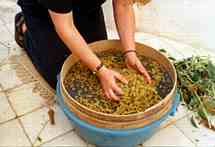Processing Amaranth Grain
Here are a few photos of us processing grain from Amaranth seedheads.
It is really easy. We include printed instructions with the seed packets,
but photos are clearer:
 First
get a big bucket of Amaranth.
First
get a big bucket of Amaranth.
It is REALLY IMPORTANT to pick it at the right stage.
Rub the flowers with your hands, and if lots of seeds are released easily, it is ready to pick.
The flowers should still be quite damp at this point, and not at all dried out.
If you let the flowers get too dry it doesn't work - most of the seed
will fall out and be taken by ants and birds, and it is very scratchy
on the hands.
 Strip
off the flowers from each seedhead, holding it by the tip and stripping
downwards.
Strip
off the flowers from each seedhead, holding it by the tip and stripping
downwards.  Now
rub through a riddle (metal sieve for soil) over a bucket.
Now
rub through a riddle (metal sieve for soil) over a bucket.
About 80% of the seeds will come out instantly and fall through the riddle. The rest are not worth bothering with. (You could do it over and over again for the last 20% but it's too much grief for very little return.)
Throw away everything that doesn't fall through the riddle.
If lots of bits of plant fall though your riddle as well, just put
it all though again, and don't rub so hard this time. (It depends on
how big the holes in your riddle are. Ours is about a quarter-inch mesh.)
 If
the seed is very damp, let it dry spread thinly on a tray in the sun
for a day or so.
If
the seed is very damp, let it dry spread thinly on a tray in the sun
for a day or so.
Then winnow the seed by pouring it from one bowl to another in a steady breeze.
In the picture the wind is coming from right to left.
You can see how the chaff has blown away onto the ground at the bottom left, while the denser grain is less affected by the wind and has gone into the bowl.
Repeat this 3 or 4 times to get rid of all the chaff.
If the wind blows stronger, pour from lower down.
The first time you try this, do it over a plastic sheet, so that
you can try again when you miss! It is very easy to get the hang of
it though.
 And
here is the final result - pure clean amaranth grain.
And
here is the final result - pure clean amaranth grain.
If you need to you can now put it through a flour sieve to remove any final impurities. But if you have got the hang of the winnowing, it should be perfectly clean already.
Dry it well on a tray in the sun or oven before storing in an air-tight container.
We cook the grain in with our rice - substituting up to about 30%. The rice cooks as normal, and it adds a nice flavour. It is a complete protein, like soya, so very good for vegetarians and vegans.
You can also put a few spoonfulls in soup and stew. It thickens it
a bit and adds a good texture.





